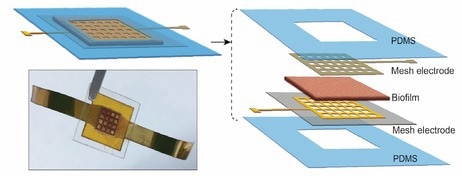University of Massachusetts Amherst researchers have recently reported that they have developed a biofilm that could absorb evaporation energy and transform it into electricity.
 Schematic view (r) and actual photo (l) of a biofilm device. Image Credit: Liu et al., 10.1038/s41467-022-32105-6
Schematic view (r) and actual photo (l) of a biofilm device. Image Credit: Liu et al., 10.1038/s41467-022-32105-6
The wearable electronics industry could soon transform thanks to this biofilm, which was published in Nature Communications, and could power anything from private health sensors to personal electronics.
This is a very exciting technology. It is real green energy, and unlike other so-called ‘green-energy’ sources, its production is totally green.
Xiaomeng Liu, Study Lead Author and Graduate Student, Electrical and Computer Engineering, UMass Amherst’s College of Engineering
This is due to the fact that this biofilm—a thin sheet of bacterial cells about the thickness of a sheet of paper—is naturally created by a modified strain of the Geobacter sulfurreducens bacterium. G. sulfurreducens produce electricity and has been used previously in “microbial batteries” to power electrical devices.
But for such batteries, G. sulfurreducens must be given sufficient attention and a steady diet. In contrast, this new biofilm, which can produce as much energy as a battery of comparable size, if not more, operates and continues to operate because it is dead. It also does not require feeding since it is dead.
It is much more efficient. We have simplified the process of generating electricity by radically cutting back on the amount of processing needed. We sustainably grow the cells in a biofilm, and then use that agglomeration of cells. This cuts the energy inputs, makes everything simpler and widens the potential applications.
Derek Lovley, Study Senior Author and Distinguished Professor, Microbiology, UMass Amherst’s College of Engineering
This new biofilm’s secret is that it generates energy from the moisture on the skin. Despite the articles about solar energy that is quite common now, nearly half of the solar energy that reaches the planet is used to evaporate water.
This is a huge, untapped source of energy.
Jun Yao, Study Senior Author and Professor, Electrical and Computer Engineering, UMass Amherst’s College of Engineering
Since the skin’s surface is always damp from perspiration, the biofilm can “plug-in” and release the energy trapped in evaporation to generate enough energy to run small gadgets.
Yao added, “The limiting factor of wearable electronics has always been the power supply. Batteries run down and have to be changed or charged. They are also bulky, heavy, and uncomfortable.”
However, all of these issues can be resolved by a transparent, small, flexible biofilm that can be worn as a patch directly on the skin and generate a continuous and reliable supply of power.
G. sulfurreducens forms colonies that resemble thin mats, and each bacterium communicates with its neighbors via a network of natural nanowires, which is what makes this whole thing possible. Once these mats have been harvested, the team utilizes a laser to etch tiny circuits into the films.
After being etched, the films are sandwiched between electrodes and then sealed in a smooth, sticky, breathable polymer that one can put on the skin. This little battery can power small gadgets once it has been “plugged in” by being placed on the body.
Yao further stated, “Our next step is to increase the size of our films to power more sophisticated skin-wearable electronics.”
According to Liu, one of their objectives is to power electronic systems as a whole as opposed to just a few individual devices.
The Institute for Applied Life Sciences (IALS) at UMass Amherst supported this study by bringing together the deep and multidisciplinary expertise of 29 departments to transform basic research into solutions that improve human health and well-being.
Journal Reference:
Liu, X., et al. (2022) Microbial biofilms for electricity generation from water evaporation and power to wearables. Nature Communications. doi:10.1038/s41467-022-32105-6.